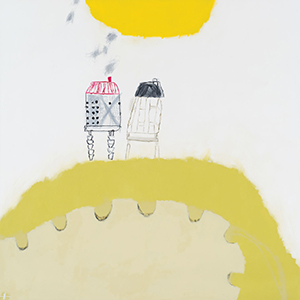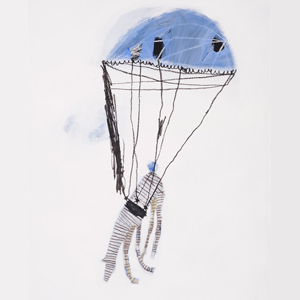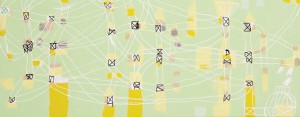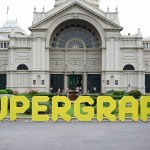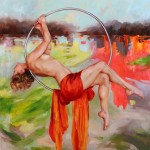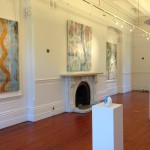Trying Not To Worry
Essay by Phe Luxford, 2014.
Examining Marise Maas’ paintings is like peering into a series of little precarious worlds – each bearing the trace of some implicit, destabilising truth. Here, roof tiles are formed from haphazard lines; windows float up and away from their foundational structures; houses teeter on disjointed stilts; electricity pylons and cranes tilt ever so slightly. On a domestic scale, small inert objects such as bowls, take-away containers or coffee cups, stack and tumble off flat slopes of colour, losing any gravitational connection to their once intended utility.
This selection of seemingly mundane motifs holds very real significance for Maas. Informed by what she describes as the bubble of her own local surroundings and domestic family life, the act of painting serves as a kind of diaristic process through which the comprehension, or perhaps apprehension, of daily life takes place. Items from the kitchen table, backyard or local sports oval all become potential vehicles for the expression of the private logic of her thoughts and fragmentary connections. Honest feelings of anxiety, consternation or whim are allowed to distort her subjects concrete actuality, giving rise to a potentially cryptic collection of amusing, somewhat ambiguous narratives.
Part of the appeal of Maas’ work lies in their admission that life, for the most part, happens within the rather uneventful ordinariness of daily routines and interactions; the bath is run, the phone is answered, the light bulb is changed. And it is while surrounded by these small things that the greater highs and lows of life unfold. Big questions mill about amongst the dishes, school bags and drawers full of socks.
Opened out and deconstructed through the act of mark making, personal restlessness and social uncertainty give way to pure, direct acknowledgement. Economical lines and restrained colours work to capture a moment when the everyday becomes quizzical, and the more or less familiar, tangible world is transformed through clear, unhampered interpretation. Much like the innocent and tangential nature of children’s visual story-telling, Maas’ images appear to delight in the loose and seemingly light-hearted. And yet, once emptied of any obligations toward representational fact, her images begin to reveal the wobbling, inconsistent nature of memory and cognition. Raw and immediate, with no desire to hide errors or corrections, her drawings operate as honest representations of some teetering interior dialogue, making visible the inner chatter of recollection.
There is a straightforward and casual bluntness to the way Maas translates her surroundings. Fusing a diagrammatical form of relationship between things with a highly restrained compositional sensibility, her images collapse the unstable nature of life into a series of therapeutic anecdotes. The world and it’s trepidations are rendered free of fear or aversion, now able to be witnessed with affection and humour.
Being open to lived moments can be luminous. Finding lessons through a process of self-awareness and pure observation reveals the delicate emotional balancing-act that underlies all things. As an artist Maas demonstrates the freedom that can come from being light with heavy thoughts.
